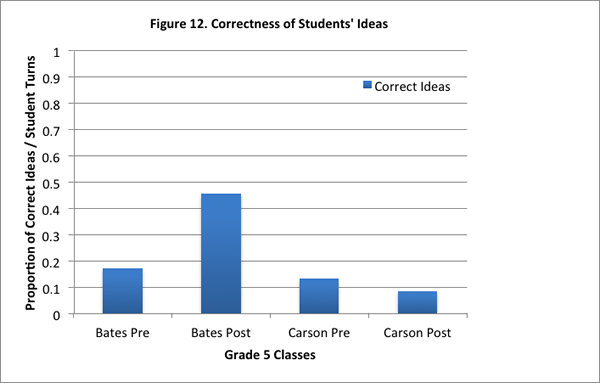Grade 5 Science Discussions 2011-2012
Classroom Discourse Findings
In combining data across all classes, we found that teachers utilized more academically productive talk moves (APT moves) in post-discussions than pre-discussions (calculated as total talk moves used across all teachers/total teacher turns across all teachers). See Figure 1. In the pre-discussions, 19.55% of the teachers’ turns involved the use of productive talk moves, whereas this figure rose to 26.03% in the post-discussions. This finding suggests that in facilitating students’ discussions, overall, the teachers incorporated into their practice the talk strategies introduced through the Talk Science PD program.
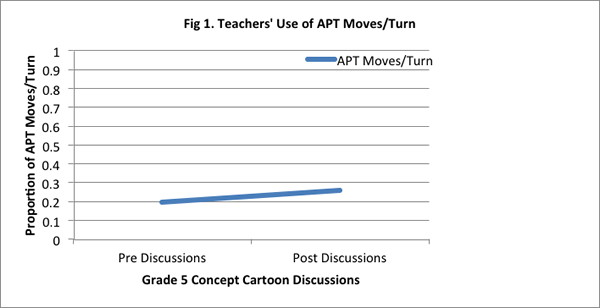
Teachers varied in the extent to which they utilized the talk moves in facilitating discussions (see Figure 2; the data are calculated with the total number of turns taken by each teacher as the denominator for the proportion of talk moves used by that teacher). For example, six of the ten teachers used some types of talk moves in the pre-discussions before participating in the Talk Science program. Furthermore, of the four teachers who did not use any talk moves in the pre-discussions, three teachers used talk moves to a considerable extent in the post-discussions, whereas one of them did not use any even in the post-discussion.
Additionally, teachers varied in their facilitation of post-discussions. They did not always increase their use of APT moves in post-discussions as compared to pre-discussions. In half of the classes, teachers used more talk moves in the post-discussions than pre-discussions.

With respect to the talk moves that were already part of teachers’ practice in the pre-discussions (see Figure 3; the data are calculated by taking the total APT moves used across all teachers as the denominator), teachers mainly used the Expand talk moves (Say More, Revoice, Time to Think) that enable students to share and clarify their ideas (66.96%; e.g., “When you use the word “volume” is there something that we could all agree on that volume is — could you say what you think volume — like how would you describe volume? What is that?”). This was followed by talk moves belonging to the Think With Others category to help students respond to their peers’ thinking (15.18%; e.g., “Okay so the air inside of this inflated soccer ball makes it weigh more why does it make it weigh more? Does anyone want to follow that idea? So he’s saying that he think that the air inside of the inflated soccer ball makes it weigh more, yes.”), and closely by Dig Deeper talk moves like challenging students and asking them for evidence and reasoning (12.5%; e.g., “So the inflated one if heavier? Okay and is there a reason why?”). Finally, teachers made least use of Listening talk moves that emphasized active listening among students (5.36%; “Okay and can you say that in your own words. Well who was saying that and can you say it in your own words?”).
A similar trend characterized the post-discussions. The Expand talk moves again dominated teachers’ practice (52.38%). Teachers increased their use of the Dig Deeper moves remarkably in the post-discussions (30.95%), suggesting that teachers began to draw increasingly on this set of talk strategies for their classroom facilitation. Further, teachers continued to use Think With Others moves (12.7%) and Listen moves (2.38%) in the post-discussions, although with both categories of talk strategies, the teachers did not increase their use in the post discussions but instead made marginally less use in post-discussions than pre-discussions.
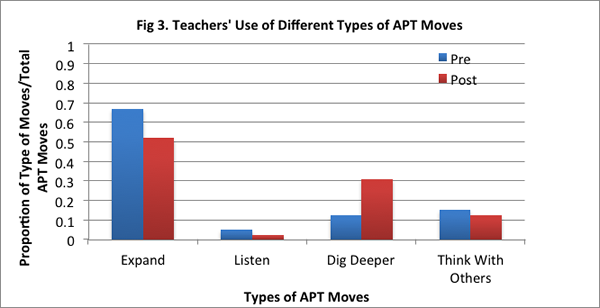
Whereas overall the teachers increased their use of the Dig Deeper talk moves, there were differences among teachers in the extent to which they used this category of talk moves in the post-discussions (see Figure 4; proportion of dig deeper moves used by each teacher is calculated by considering the total number of talk moves used by that teacher).
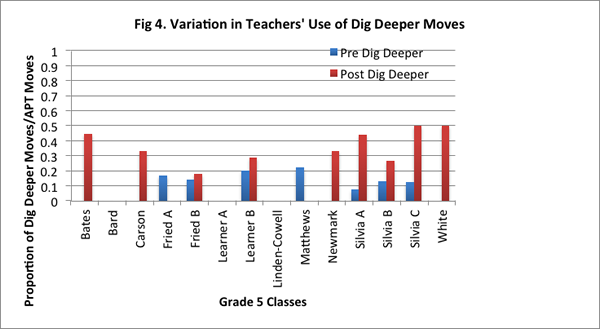
With respect to students’ talk, combining data from all classes, we found that students increased their attempts at co-constructing ideas with peers in the post-discussions (17.34%). In the pre-discussions, co-construction accounted for 13.42% of their turns. See Figure 5.
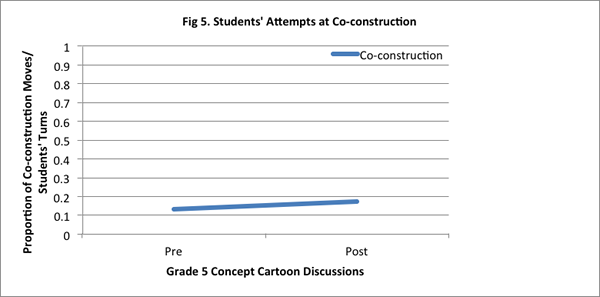
Although there was an increase overall in students’ co-construction, it was a small difference and could be understood better by looking at the data separately for each of the classes. Specifically, a closer examination revealed that students in eight of the fourteen classes made greater attempts at co-construction in the post-discussions than pre-discussions (see Figure 6).
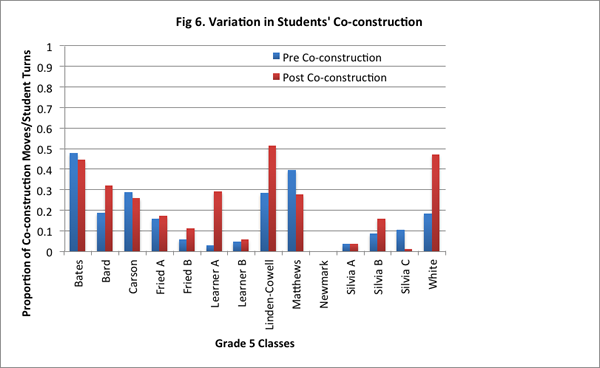
Our analysis also identified students’ attempts at making sense of the science, which consisted of revising one’s thinking; raising related questions pertaining to the science during the discussion; and proposing experiments or generating thought experiments to test ideas in the concept cartoon (see Figure 7; data combined from all 14 classes). In the pre-discussions, 5.21% of students’ talk involved sense-making attempts (e.g., (propose experiment) “Well I think there is a way you can tell if air weighs anything, like just take a jar with the cap off and just leave it somewhere and weigh it, like a very accurate scale, so it weighs something, and then put it in like an anti-gravity chamber where there’s no air and weigh it again and see if there’s a difference”; (raise related question) “Well I just have a question, like because when you’re pumping up a ball or like the bicycle tire or whatever it says how many pressure of air, so I’m wondering if that would make a difference on the weights?”).
In the post-discussions, students made fewer sense-making attempts in their turns at talk, accounting for 1.84% of their talk. This decrease in students’ sense-making attempts may be understood further in light of changes in students’ use of the three types of sense-making attempts, and changes in their reasoning with and without the science ideas from the curriculum.
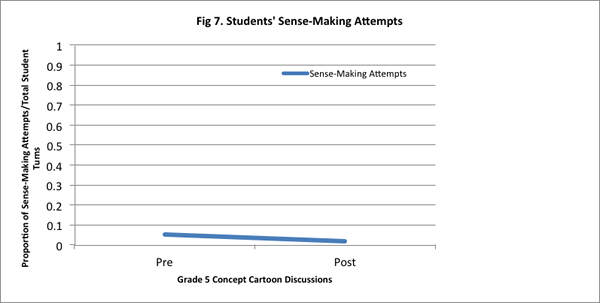
A closer examination of students’ sense-making attempts focused on the extent to which they made three types of attempts in pre- and post- discussions (See Figure 8; these data are taken from all 14 classes, and are calculated as the proportion of particular types of sense-making attempts from the total number of sense-making attempts made by students). The findings showed that in the pre-discussions, students mainly proposed ways to test the ideas in the concept cartoon (65.79%), followed by attempts to revise their own thinking (21.05%), and raising new questions related to the science in the discussions (13.16%).
In the post-discussions, the principal difference occurred in the extent to which students proposed experiments and tests for the competing claims in the concept cartoon. These attempts accounted for 37.5% of the total sense-making attempts made by students, thereby revealing a substantial decrease in this type of attempt compared to the pre-discussions. On the other hand, the other two types of attempts (revising their thinking, and raising related questions) each accounted for 31.25% of the total sense-making attempts in the post-discussions. See Figure 8.
A possible explanation for the decrease in students’ attempts at proposing tests and thought experiments is as follows: In the pre-discussions when students do not always have a solid understanding of the science concepts and principles that are introduced subsequently through the curriculum, students may generate ideas frequently for testing the concept cartoon claims as a way to make meaning of the science and resolve conflicting claims. On the other hand, when students participate in post-discussions after having several investigations and conversations about core science ideas, they may be able to draw on their understandings of the core ideas from the curriculum to resolve the conflicting claims.
The explanation proposed needs to be examined further because the analysis did not identify the extent to which teachers prompted students to propose tests and thought experiments in the pre- and post-discussions. The prevalence of tests and thought experiments proposed in the pre-discussions may be a function of greater probing by the teachers to do so prior to introducing the curriculum. The teachers may have made fewer explicit attempts in the post-discussions to probe students’ ideas for testing the claims, particularly if there was greater convergence in students’ thinking by the end of the curriculum, or if students were drawing often on the science learned through the curriculum to formulate their thinking.

With respect to reasoning with and without core science ideas (see Figure 9; data combined from all 14 classes; proportions are calculated based on total student turns), in the pre-discussions, students’ reasoning on the basis of core science ideas (scientific principles and prior classroom investigations) accounted for 2.47% of their talk (e.g., “Like it would weigh about the same but like exactly the ball, the inflated ball, would weigh more probably because air does have weight but just very little and so it’s, kind of, true”; “ Well I agree with Aaron because a couple of years ago I learned that the only reason you weigh something is because that’s the amount of air from pressure pushing down on you, but you don’t feel it because you’re used to it, so the only reason something will weigh something is because the air is pushing down on it and that’s going to weigh something. So the air does weigh a little.”).
On the other hand, students’ reasoning without core science ideas (everyday experiences, asserting facts/opinions, analogies, etc.) accounted for 35.75% of their talk in the pre-discussions. This trend in during pre-discussions was not surprising because prior to the curriculum, with little first-hand experience with the core science ideas, students are likely to reason more on the basis of their everyday experiences and ideas.
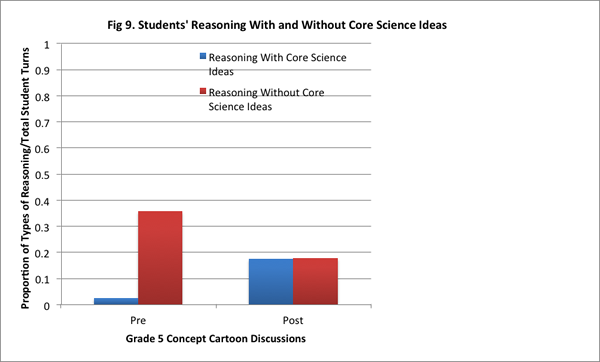
In the post-discussions, students drew often on classroom investigations and scientific principles from the Grade 5 curriculum, accounting for 17.56% of their talk. They continued also to reason on the basis of ideas and experiences from outside the curriculum, accounting for 17.8% of their talk. It should be noted that there was only a marginal difference in the two forms of reasoning in the post-discussions as compared to the pre-discussions. This finding shows that in contributing to the post-discussions to make sense of a novel task (the concept cartoon), students tried to apply actively their understanding of core science ideas from the curriculum (through references to scientific principles and classroom investigations), and were apt to reason almost equally with and without the core science ideas.
The related findings that students drew almost equally on scientific principles and classroom investigations, and their ideas and experiences from outside the curriculum in the post-discussions, and that they referred more often to core science ideas in post-discussions than in pre-discussions may shed light on a prior finding that students made fewer attempts at proposing experiments in the post-discussions (see Figures 7 and 8). It is possible that after being introduced to scientific concepts and principles through the curriculum investigations, students could draw on the core science ideas to resolve conflicting claims, and hence felt less need to generate ideas and thought experiments.
The reader should note that the increase in students’ reasoning with core science ideas in the post-discussions was found in all 14 classes. See Figure 10.
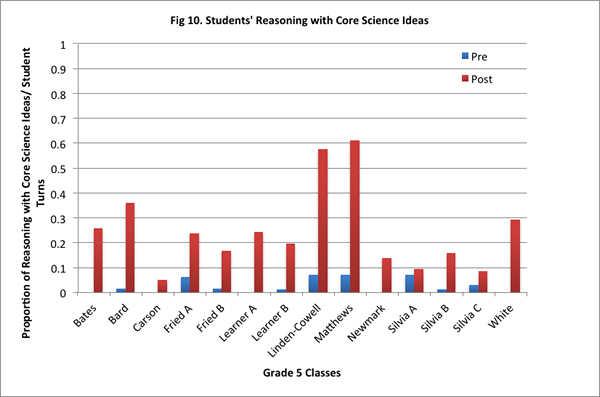
A careful study of students’ reasoning with core science ideas revealed also that students referred more often to data and observations from their classroom science investigations in the post-discussions (see Figure 11; data combined from 14 classes; proportions calculated from total attempts at reasoning with core science ideas). This finding shows that after conducting the investigations, students could utilize their observations and experiences to reason about a novel task.
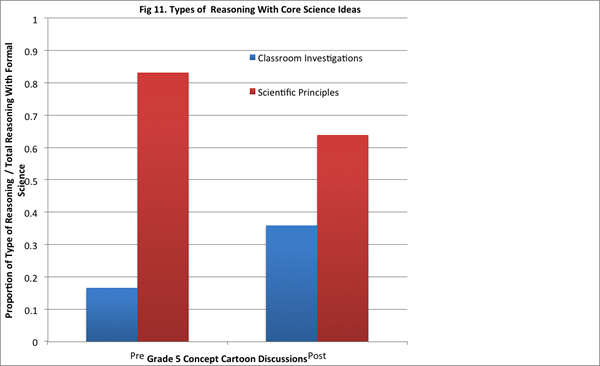
Finally, as stated before, our analysis examined a subset of pre- and post-discussions from two of the classes, Ms. Bates’ and Ms. Carson’s, to understand the extent to which students offered correct ideas during the discussions (see Figure 12). We found that a greater number of student turns in the post-discussions in Ms. Bates’ class presented correct ideas to the discussion (approximately 46% of students turns) than in the pre-discussion (approximately 17% of students turns). On the other hand, there was an opposite trend in Ms. Carson’s class, where approximately 13% of student turns in the pre-discussion presented correct ideas, whereas fewer turns in the post-discussion contained correct ideas (approximately 9%). This finding shows that at least in one of the classes, students generated correct ideas more often in the post-discussion than in the pre-discussion. These data allow us to glimpse into the accuracy of students’ reasoning, and additional analysis is needed to determine specifically the extent to which students applied correctly the core science ideas they learned from the curriculum in contributing to the discussion.
